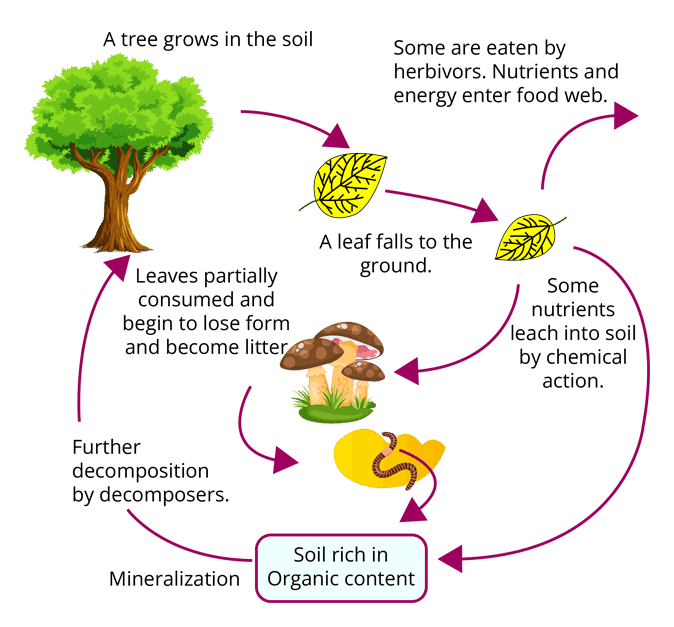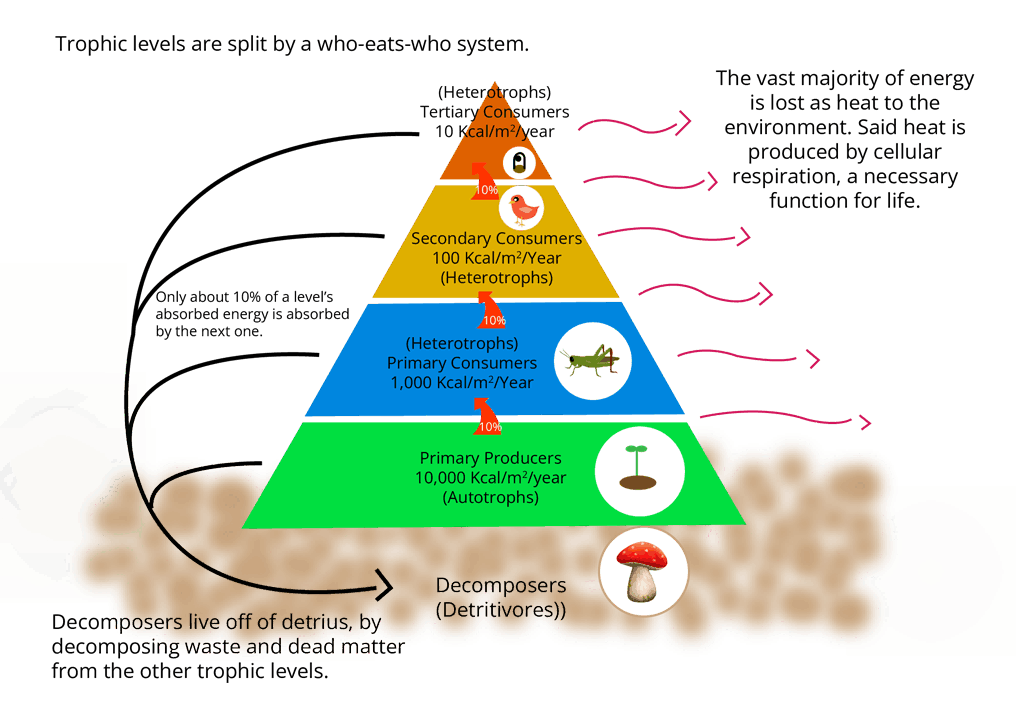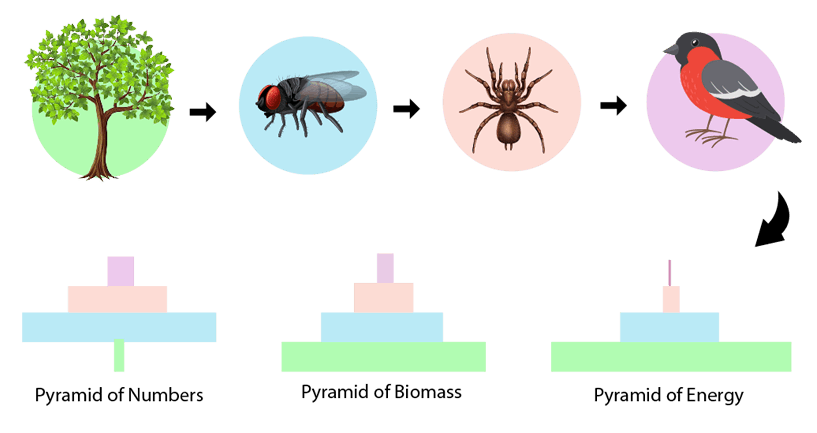




Ecosystem
Introduction
This document contains the chapter named ecosystem as per the NEET syllabus for Biology. It will be fruitful for NEET aspirants who are looking for the last-minute revision notes.
The following document contains all of the important topics and provides the insight of the exam pattern. By going through this document, one can find out all the answers to the important questions related to the chapter such as what is the ecosystem, what are its importance, how the energy flows through the ecosystem, what are the types of productivity, what is ecological succession, etc.
Important Topics of Ecosystem
Ecosystem: structure & function
Productivity
Decomposition
Energy flow
Ecological pyramids
Ecological succession
Important Concepts
Ecosystem Structure and Function
An ecosystem is the system where organisms interact with each other (living and nonliving). It is the basic unit of an environment. It consists of plants, animals, microorganisms, and all other living things along with their nonliving environment, which includes soil, land, air, water, dust, etc.
In nature, it can be small or large depending upon the number of abiotic components available in the environment.
Components of Ecosystem
There are basically two components of the ecosystem such as:
Abiotic: It includes non-living components such as rain, light, temperature, wind, soil, pH, minerals, etc.
Biotic: It includes living components such as autotrophic and heterotrophic organisms.
Types of Ecosystem
There are basically two types of ecosystems such as:
Aquatic Ecosystem
Terrestrial Ecosystem
Function of Ecosystem
The primary function of the ecosystem is the exchange of energy from one life form to another life form, thus sustaining the entire life on the planet.
Productivity
It is defined as the percentage of energy that enters the ecosystem in the form of biomass at a particular trophic level. It can be measured by mass per unit volume or surface per unit of time.
Decomposition
The process which involves the breakdown of complex organic matter into simpler inorganic substances like carbon dioxide, water, and nutrients. The organisms that can perform the process of decomposition are called detritivores. The example includes earthworms.
The process of decomposition depends upon a variety of factors as mentioned below:
Litter Quality
Temperature
Aeration
Soil pH
Inorganic Chemicals
Moisture
The major steps of decomposition are as follows:
Fragmentation
Leaching
Catabolism
Humification
Mineralization

Energy Flow
It is defined as the flow of energy through living things within an ecosystem which is based upon the law of thermodynamics. We receive approximately 40-50% of the energy having Photosynthetically Active Radiation (PAR) and only around 2-10% of it is used by plants for the process of photosynthesis. The energy flow takes place via the food chain and food web.

Ecological Pyramids
These are the graphical representations that show the relationship between the different organisms in an ecosystem. They are of three types:
Pyramid of Number - This type of pyramid compares the no. of organisms at each trophic level.
Pyramid of Biomass - This type of pyramid compares the mass of biological material at each trophic level.
Pyramid of Energy - This type of pyramid compares the amount of energy that passes through each trophic level over a period of time.

Ecological Succession
Succession is defined as the colonization of species in an ecosystem from a barren or destroyed area of land.
There are a variety of causes that result in ecological successions such as climatic causes, biotic causes, and external causes. There are basically seven steps in ecological succession i.e. nudation, migration, ecesis, aggregation, competition, reaction and stabilization, and climax.
Solved Examples From the Chapter
1. Why is the pyramid of energy always upright?
Ans: The pyramid of energy is always upright because the flow of energy is always unidirectional, it means from producers to the consumers. The amount of the energy decreases as it goes from one trophic level to the next trophic level.
2. Differentiate between the grazing food chain and detritus food chain?
Ans:
3. Differentiate between production and decomposition.
Ans:
4. Why do lichens act as the pioneer community?
Ans: Succession is defined as the colonization of species in an ecosystem from a barren or destroyed area of land.
The Pioneer community is the first biotic community that develops in the bare areas. This stage has very little diversity and takes the longest time to change the environment for the invasion of the next community. Lichens act as the pioneer community because they have the ability to settle on substrates that are very low in nutrients and also can withstand extreme temperature and light conditions. On bare rocks, they secrete carbonic acid which leads to rock weathering and the creation of soil.
Solved Problems of Previous Year Question From the Chapter
1. The mass of living materials at a trophic level at a particular time is called ____.
A. Standing state
B. Standing crop
C. Gross primary productivity
D. Net primary productivity
Ans: The correct answer is option “B”.
Gross Primary Productivity: It is defined as the rate at which an ecosystem's producers capture and store a given amount of chemical energy as biomass in a given length of time.
Net Primary Productivity: It is defined as the available biomass for the consumption of heterotrophs (who can not prepare their own food) such as herbivores and decomposers.
Standing-state: It is defined as the amount of inorganic nutrients present in an ecosystem.
2. What percentage of the PAR is captured by the green plants?
A. 5 – 10%
B. 7 – 10%
C. 8 – 10%
D. 2 – 10%
Ans: The correct answer is option ‘D’.
PAR stands for photosynthetically active regions. It is the portion of the light that is
used by green plants for photosynthesis. It comes in between the wave-length range of
400-700 nm.
3. The term ecosystem was coined by
A. E.Haeckel
B. E.Warming
C. Odum
D. A.G.Tansley
Ans: The correct answer is option ‘D’.
An ecosystem is a system where organisms interact with each other (living and nonliving). It is the basic unit of an environment. It consists of plants, animals, microorganisms, and all other living things along with their nonliving environment, which includes soil, land, air, water, dust, etc.
Practice Questions
1. The largest ecosystem in the world is?
A. Forests
B. Grasslands
C. Great lakes
D. Oceans
Ans: The correct answer is option ‘D’.
The ocean is the largest existing ecosystem which covers approximately 71% of the Earth's surface.
2. Which of the following statements is true?
A. Decomposition rate is slower if detritus is rich in lignin and chitin and quicker if detritus is rich in nitrogen and water-soluble substances like sugars.
B. Decomposition rate is slower if detritus is rich in nitrogen and water-soluble substances like sugars and quicker if detritus is rich in lignin and chitin.
C. Decomposition rate is slower if detritus is rich in cellulose and quicker if detritus is rich in phosphorus.
D. Decomposition rate is quicker if detritus is rich in lignin and quicker if detritus is rich in sulfur.
Ans: The correct answer is option ‘A’.
The process involves the breakdown of complex organic matter into simpler inorganic substances like carbon dioxide, water, and nutrients. The organisms that can perform the process of decomposition are called detritivores. The example includes earthworms.
The process of decomposition will be slow in the case of compounds rich in cellulose/lignin/chitin and will be fast in the case of nitrogen and water-soluble substances.
3. The sequence of communities of primary succession in water is:
A. phytoplankton, sedges, free-floating hydrophytes, rooted hydrophytes, grasses, and trees.
B. phytoplankton, free-floating hydrophytes, rooted hydrophytes, sedges, grasses, and trees.
C. free-floating hydrophytes, sedges, phytoplankton, rooted hydrophytes, grasses, and trees.
D. phytoplankton, rooted submerged hydrophytes, floating hydrophytes, reed swamp, sedges, meadow, and trees.
Ans: The correct answer is option ‘D’.
Succession is defined as the process of the natural development of a series of biological communities at the same time one after the other until a climax community is developed which is in perfect harmony with the environment. Primary succession occurs on sterile or bare areas and the succession which occurs in water is called hydrosere.
Conclusion
This article contains all the important information as per the requirement of students who are preparing for the NEET and can be really helpful for a quick and effective revision. It includes all the important concepts and topics, questions from the previous year's NEET exam, NEET mock test as well as the Biology NCERT. Make sure to try the Practice question on your own to test your knowledge and to get desired outputs.
FAQs on NEET Important Chapter - Ecosystem
1. Is the ecosystem important for NEET?
Yes, it is important for the NEET exam because it covers most of the important topics and the concepts that are useful for the exam.
2. Is NCERT enough for preparing for the NEET exam?
Yes, it is enough. One can score very well by going through it again and again because every time a person receives new information which is very important in terms of exams.
3. What are the important topics of the chapter ecosystem?
Although it is one of the most important chapters in terms of the NEET exam, some of the important topics from which the questions are asked are the ecosystem – structure and function, productivity, decomposition, energy flow, ecological pyramids, ecological succession, etc.









